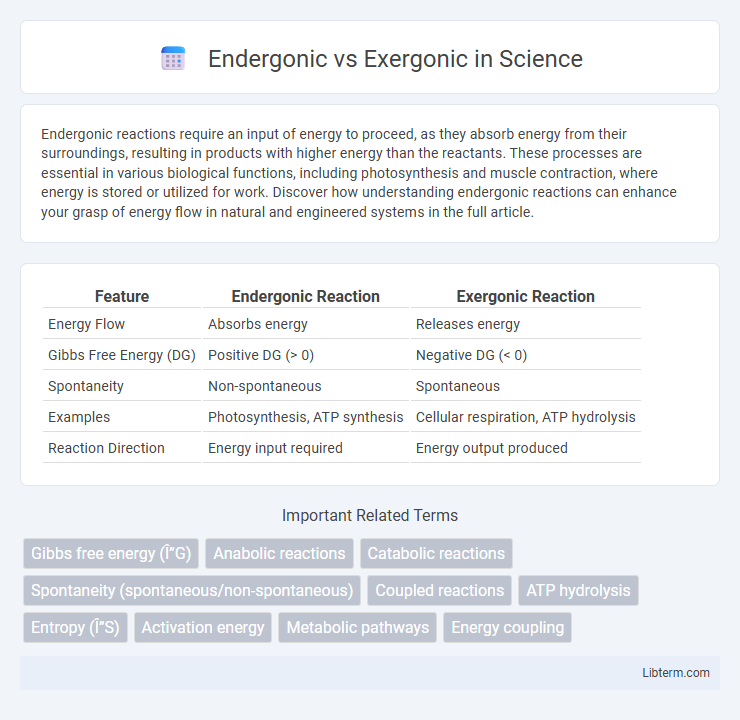Endergonic reactions require an input of energy to proceed, as they absorb energy from their surroundings, resulting in products with higher energy than the reactants. These processes are essential in various biological functions, including photosynthesis and muscle contraction, where energy is stored or utilized for work. Discover how understanding endergonic reactions can enhance your grasp of energy flow in natural and engineered systems in the full article.
Table of Comparison
| Feature | Endergonic Reaction | Exergonic Reaction |
|---|---|---|
| Energy Flow | Absorbs energy | Releases energy |
| Gibbs Free Energy (DG) | Positive DG (> 0) | Negative DG (< 0) |
| Spontaneity | Non-spontaneous | Spontaneous |
| Examples | Photosynthesis, ATP synthesis | Cellular respiration, ATP hydrolysis |
| Reaction Direction | Energy input required | Energy output produced |
Introduction to Endergonic and Exergonic Reactions
Endergonic reactions require an input of energy to proceed, characterized by a positive Gibbs free energy change (DG > 0), indicating non-spontaneity. Exergonic reactions release energy, with a negative Gibbs free energy change (DG < 0), making them spontaneous processes that can drive cellular activities. Understanding the energy flow in these reactions is essential for metabolic pathway analysis and bioenergetics studies.
Defining Endergonic Reactions
Endergonic reactions are chemical processes that require an input of energy to proceed, characterized by a positive Gibbs free energy change (DG > 0). These reactions absorb energy from their surroundings, often in the form of ATP hydrolysis in biological systems. Endergonic reactions are crucial for biosynthesis, active transport, and cellular growth, contrasting with exergonic reactions that release energy.
Key Features of Exergonic Reactions
Exergonic reactions release free energy, characterized by a negative Gibbs free energy change (DG < 0), indicating spontaneous processes that occur without energy input. These reactions drive biological processes such as cellular respiration by breaking down molecules and transferring energy to ATP synthesis. Key features include energy release, increased entropy, and the capability to perform work in metabolic pathways.
Energy Changes: Absorption vs Release
Endergonic reactions involve the absorption of energy, requiring an input to proceed and resulting in products with higher free energy than the reactants. Exergonic reactions release energy as they progress, producing products with lower free energy and often driving cellular processes. The key difference lies in the direction of Gibbs free energy change: positive for endergonic and negative for exergonic reactions.
Role of Gibbs Free Energy
Gibbs free energy (DG) determines whether a biochemical reaction is endergonic or exergonic by indicating the spontaneity and energy change involved. Endergonic reactions have a positive DG, requiring energy input to proceed, while exergonic reactions have a negative DG, releasing energy as they occur. Understanding DG allows prediction of reaction direction and feasibility in metabolic pathways.
Examples of Endergonic Processes
Photosynthesis is a prime example of an endergonic process where plants absorb sunlight to convert carbon dioxide and water into glucose, storing energy in chemical bonds. Protein synthesis in cells also requires energy input to assemble amino acids into polypeptide chains, driven by ATP hydrolysis. Another key endergonic reaction is the active transport of ions across membranes, which consumes cellular energy to move substances against their concentration gradient.
Examples of Exergonic Processes
Cellular respiration is a prime example of an exergonic process, where glucose is broken down to release energy in the form of ATP. Other examples include the breakdown of ATP to ADP and inorganic phosphate, which powers various biological functions. Combustion reactions, such as the burning of gasoline, also release energy and demonstrate exergonic characteristics.
Biological Significance in Metabolism
Endergonic reactions require energy input to proceed and are essential for anabolic processes like biosynthesis and active transport in cells, enabling the formation of complex molecules from simpler ones. Exergonic reactions release energy, typically harnessed to drive cellular activities such as ATP synthesis and catabolic pathways that break down nutrients for energy production. The coupling of endergonic and exergonic reactions maintains cellular energy balance and supports metabolic homeostasis critical for growth, repair, and survival.
Factors Influencing Reaction Direction
Factors influencing the direction of endergonic and exergonic reactions include Gibbs free energy change (DG), reactant and product concentrations, temperature, and pressure. A negative DG favors exergonic reactions, releasing energy and proceeding spontaneously, while a positive DG drives endergonic reactions, requiring energy input. Cellular conditions and enzyme activity also shift reaction equilibria, impacting the spontaneity and direction of metabolic pathways.
Comparing Endergonic vs Exergonic in Everyday Life
Endergonic reactions require energy input to proceed, such as muscle contraction during exercise, where ATP is consumed to power movement. Exergonic reactions release energy, evident in cellular respiration, where glucose breakdown generates ATP to fuel bodily functions. Understanding the balance between endergonic and exergonic processes explains energy flow essential for metabolism and maintaining life.
Endergonic Infographic

 libterm.com
libterm.com